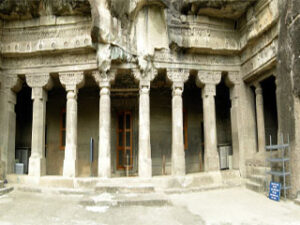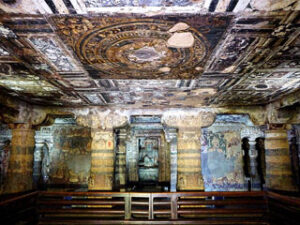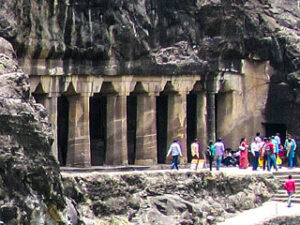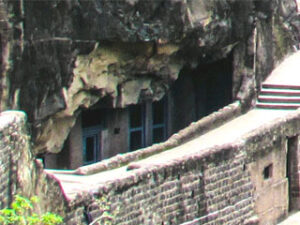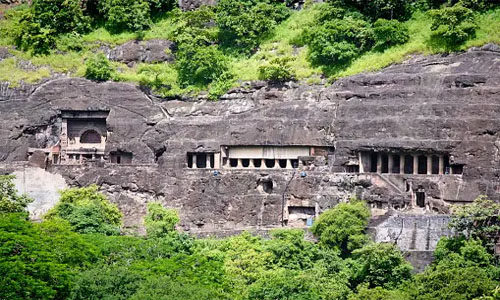Aurangabad To Ajantha | Ajantha To Aurangabad
Cave 1: was built on the eastern end of the horseshoe-shaped scarp and is now the first cave the visitor encounters. This cave, when first made, would have been in a less prominent position, right at the end of the row. According to Spink, it is one of the last caves to have been excavated, when the best sites had been taken, and was never fully inaugurated for worship by the dedication of the Buddha image in the central shrine.
Cave 2: adjacent to Cave 1, is known for the paintings that have been preserved on its walls, ceilings, and pillars. It looks similar to Cave 1 and is in a better state of preservation. This cave is best known for its feminine focus, intricate rock carvings and paint artwork yet it is incomplete and lacks consistency. One of the 5th-century frescos in this cave also shows children at a school, with those in the front rows paying attention to the teacher, while those in the back row are shown distracted and acting.
Cave 3: a Vihara, was sponsored by Mathura, likely not a noble or courtly official, rather a wealthy devotee. This is the largest vihara in the inaugural group, which suggests he had immense wealth and influence without being a state official. It is placed at a significantly higher level, possibly because the artists realized that the rock quality at the lower and same level of other caves wa
Cave 4: is another unfinished monastery (15.24 × 24.64 m). For many decades in the 20th century, this cave was used as a storage and generator room. It is at the river level with easy access, relatively lower than other caves, and according to Archaeological Survey of India it is possibly one of the earliest monasteries. Much of its front is damaged, likely from a landslide. The cave excavation proved difficult and probably abandoned after a geological fault consisting of a mineral layer proved disruptive to stable carvings.
- Distance : 100 KM
- Time: 2Hr 19Min
Explore Ajantha
There are 29 Buddhist caves at Ajanta dating to between the 2nd century BC and 6th century AD. These include both monasteries (chaityas) and worship-halls (viharas). They are adorned with rock-cut sculptures and paintings that represent some of the finest examples of ancient Indian art.
While they are often clubbed together, Ajanta and Ellora Caves are two separate sites more than 100km apart. There are 29 Buddhist caves at Ajanta dating to between the 2nd century BC and 6th century AD.
These include both monasteries (chaityas) and worship-halls (viharas). They are adorned with rock-cut sculptures and paintings that represent some of the finest examples of ancient Indian art.
Ajantha & It's Surrounding
Book A Cab From Aurangabad To Ajantha Taxi
For a trip to Ajantha, renting a taxi from Xpress Cab Rental provides comfort, dependability, and convenience. You can have a stress-free and pleasant ride with a fleet of well-maintained vehicles and competent drivers. Additionally, Xpress Cab Rental guarantees reasonable prices, which makes it an affordable option for your trip to Ajantha.
– Thankyou
